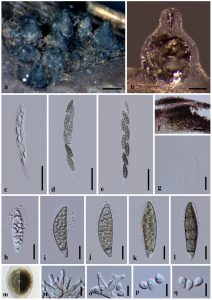Tirisporella beccariana (Ces.) E.B.G. Jones, K.D. Hyde & Alias, Can. J. Bot. 74(9): 1490 (1996)
Index Fungorum number: IF 415898
Saprobic on submerged petiole of Nypa fruticans. Sexual morph: Ascomata 590–740 µm in diameter, 840–1020 µm high (x̅ = 660 × 864 µm, n = 10), black, solitary or gregarious, globose to subglobose, uniloculate, coriaceous to carbonaceous, superficial, with a short neck and central ostiole, periphysate. Peridium 95–125 µm wide, reddish brown to dark brown, comprising outer thick layers of textura angularis, and inner layers of prosenchymatous or elongate cells. Paraphyses 4.5–9 µm wide, hyaline, unbranched, septate, constricted at the septa and tapering. Asci 125–220 × 15–21 µm (x̅ = 175.5 × 18.3 µm, n = 20), 8-spored, short pedicellate, apex flattened, with a J-, subapical ring. Ascospores 28–45 × 6–11 µm (x̅ = 37.6 × 7.6 µm, n = 30), biseriate, brown, falcate to lunate, or ellipsoid, 4-septate, verrucose, apical cell appendaged, basal cell pointed and hyaline. Asexual morph: Hyphomycetous. Cultures grow well on PDA and MEA, forming greenish to dark brown colonies. Mycelium composed of branched, septate, hyaline to brown hyphae. Conidiophores macronematous, mononematous, erect, pale brown to brown, pale toward the apex, straight or flexuous, smooth. Conidiogenous cells 5.5–12 × 2–4 µm (x̅ = 8.6 × 3.1 µm, n = 32), enteroblastic, monophialidic, integrated on hyphae, terminal, sometimes erect on hyphae, pale brown, subcylindrical, ampulliform. Conidia 3–5.5 × 1.5–3.5 µm (x̅ = 4 × 2.6 µm, n = 80), unicellular, hyaline, fusoid-ellipsoid, obovoid or ellipsoid, obtuse or broadly rounded at apex, tapering to a truncate base, smooth-walled.
Material examined – Thailand, Ranong, Ngao (Ranong) Mangrove Forest Research Center, on intertidal petiole of Nypa fruticans (Arecaceae), 7 December, 2016, S.N. Zhang, SNT82 (MFLU 18-1582, HKAS 97482), living culture MFLUCC 18-1572; Thailand, Prachuap Khiri Khan, Pak Nam Pran, on intertidal petiole of Nypa fruticans, 2 December, 2016, S.N. Zhang, SNT102 (MFLU 18-1584), living culture MFLUCC 18-1571; Thailand, Krabi, Pali, on intertidal petiole of Nypa fruticans, 30 August, 2017, S.N. Zhang, SNT203 (MFLU 18-1585, HKAS 97483).
GenBank numbers – LSU: MK078627 (MFLUCC 18-1572), MK078628 (MFLUCC 18-1571), MK078629 (MFLU 18-1585); SSU: MK078631 (MFLUCC 18-1572), MK078632 (MFLUCC 18-1571), MK078633 (MFLU 18-1585); TEF1-α: MK087664 (MFLUCC 18-1572), MK087665 (MFLUCC 18-1571), MK087666 (MFLU 18-1585).
Known distribution (based on molecular data) – Thailand (Jones et al. 1996, Suetrong et al. 2015, this study).
Known hosts (based on molecular data) – Nypa fruticans (Jones et al. 1996, Suetrong et al. 2015, this study).
Notes – The phylogenetic analysis indicates that the three new isolates of the current study clustered together with five strains of T. beccariana with strong support (Fig. 50). The sequences of these new isolates and previous T. beccariana isolates are similar, with only 5 gaps in the LSU sequence. Additionally, the morphological characters in both asexual and sexual morphs are consistent with the previous studies (Jones et al. 1996, Suetrong et al. 2015). Thus, we consider the new isolates conspecific to T. beccariana.
Fig – Tirisporella beccariana (MFLU 18-1582, MFLU 18-1585, Additional collections). a Appearance of ascomata on host surface with ostioles. b Vertical section through the ascoma. c–e Asci. f Peridium. g Paraphyses. h–l Ascospores. m Colony on PDA. n–q Sporulation in culture. Sacle bars: a = 500 μm, b = 200 μm, c–f = 50 μm, g = 20 μm, h–l = 10 μm, n–o = 5 μm.

